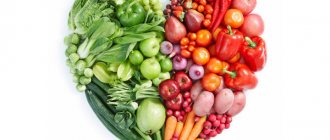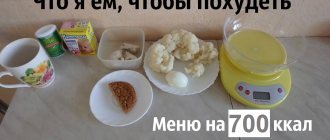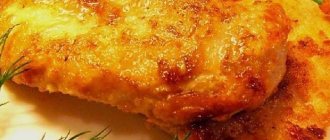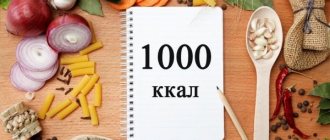What is the glycemic index of foods?
The glycemic index of food products is understood as an indicator of the speed of their breakdown and further conversion into glucose. Depending on the speed of digestion of food in the body, a large amount of glucose is formed, which contributes to an increase in blood sugar.
Glycemic index of foods: a complete table for weight loss is presented in this article.
The GI of overripe vegetables and fruits, as well as the long shelf life of plant products, only contributes to an increase.
This process is inherent in foods with a high GI. Foods with a low glycemic index are digested much more slowly, creating a feeling of prolonged satiety and satiety in a person.
Based on research data, doctors and nutritionists have compiled more than one weight loss table with the glycemic index of foods.
What does the GI of a product depend on?
The glycemic index of food eaten by a person depends on the following factors:
- from additives and impurities contained in food;
- from methods of thermal and mechanical processing of food;
- on the temperature of the product itself;
- on the degree of maturity and shelf life of the products.
Interesting fact! Nutritionists say that the GI of fresh carrots from the garden is 20 units. But after boiling it, the index rises by 30 units, and the calorie content of carrots becomes equal to that of rich rolls.
The GI of overripe vegetables and fruits, as well as the long shelf life of plant products, only contributes to an increase.
Flour products and cereals
Indicators of GI, nutritional value and calorie content of cereals are directly dependent on the type of raw materials used and the method of its processing, and flour products - on the type of flour. The most useful cereals are those that have not undergone polishing and removal of the shell (brown rice, oatmeal). It is the shell that contains a huge amount of protein, B-vitamins, iron, tocopherol, essential amino acids and minerals. In addition, unrefined cereals have a lower GI, since they are characterized by slow absorption of carbohydrates from the gastrointestinal tract into the bloodstream.
Important! Cereals and flour products contain up to 80% carbohydrates, up to 13% proteins, and no more than 6% lipids. The average calorie content is 320-350 kcal per 100 g of product.
Popular cereals that are popular with diabetics and those who decide to lead a healthy lifestyle:
- Buckwheat (GI 40-55, 355 kcal) – boiled cereal has a lower glycemic index than boiled cereal. It has a significant amount of iron and is practically not saturated with lipids. It is advisable to consume it in the first half of the day with proteins.
- Rice (white - 65 and 339 kcal, brown - 45 and 303 kcal) is rich in B vitamins and essential amino acids.
- Millet (GI 70, 348 kcal) - it is advisable to make a thin porridge, then it has less sugar. Binds free radicals, removes excess cholesterol, has a positive effect on the liver, and activates the gastrointestinal tract.
- Wheat cereals (GI from 40 to 65) - this group includes arnoutka, couscous, bulgur and spelt. The product is high in calories, but reduces glucose levels, stimulates regeneration processes, the functioning of the intestinal tract, and improves the activity of the central nervous system.
- Corn grits (GI up to 70, 353 kcal) - has a significant amount of magnesium, zinc, iron, vitamins B, A.
- Pearl barley (GI up to 30, 350 kcal) is a leader in safety and useful ingredients. Contains a lot of protein, fiber, microelements, and has the ability to reduce the amount of glucose in the blood.
- Barley groats (raw - 35, boiled - 50, 349 kcal) - can reduce cholesterol levels, normalize the functioning of the central nervous system, and strengthen the immune system.
- Oatmeal (GI 40, 371 kcal) is a safe and healthy product, but the flakes should be used without additives or impurities.
Flour products belong to the high glycemic index group (70-95). The composition includes quickly digestible carbohydrates, which provide long-term saturation, but at the same time sharply increase sugar levels.
Complete table of weight loss foods with glycemic index
The table below gives an idea of the glycemic index of the foods a person eats.
Table of foods with a high glycemic index of 70 and above
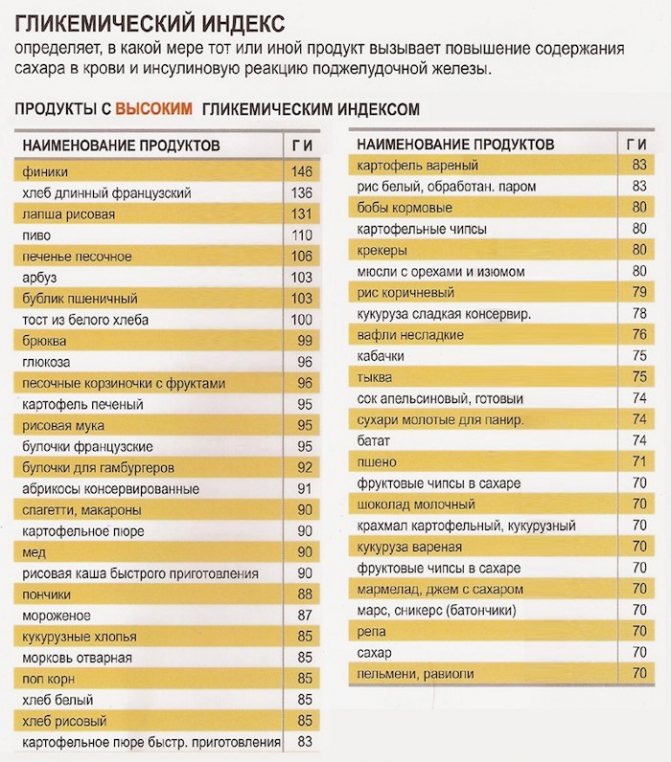
Table with average glycemic index from 50 to 69

Table of foods with a low glycemic index of 49 and below
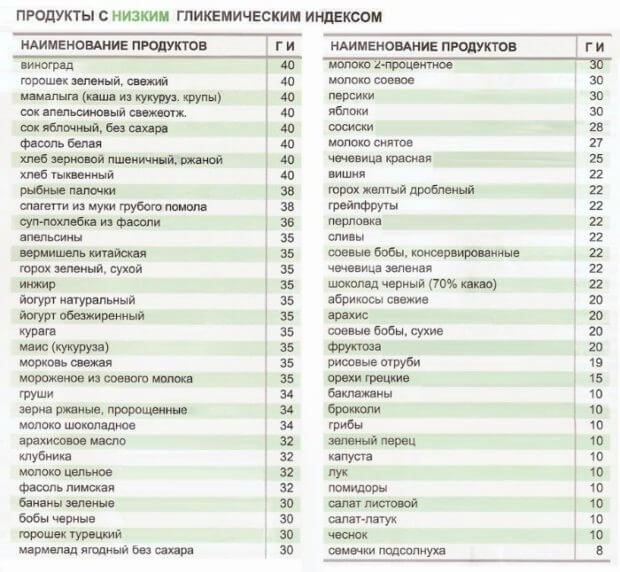
When should you consume high GI foods?
For those people who have decided to lose excess weight and lead a sedentary lifestyle, nutritionists will never recommend eating food with a high glycemic index of 80 or more units.
This food will contribute to the deposition of fat in the body, as clearly evidenced by the glycemic index of foods in the weight loss table.
But for athletes who train twice a day and need to build muscle, eating foods with a high GI is never harmful.
Calorie content
Caloric content is the amount of energy that the body receives in the process of consuming certain foods as a result of their breakdown into simple substances. The energy value of food is measured in kilocalories (kcal). Oxidation provides the body with the following amount of energy:
- 1 g protein – 4 kcal;
- 1 g of lipid – 9 kcal;
- 1 g carbohydrate – 4 kcal.
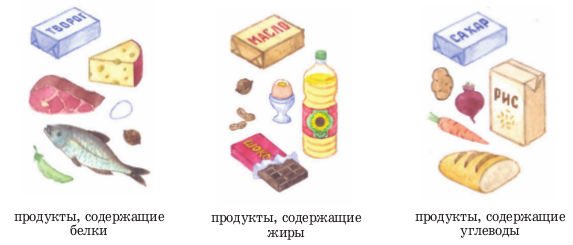
Knowledge about the components of the product - the ability to correct your personal diet
Knowing the amount of constituent substances, you can calculate how much energy a person will receive from the food he eats.
Squirrels
The body's daily requirement is about 2 g per kilogram of body weight. More than half of the incoming substance should be of plant origin. When creating an individual diet, you should include those foods that are rich in proteins, but at the same time have low calorie content.
Lipids
It is necessary to reduce the amount of animal fats and increase plant lipids. Animal lipids provoke an increase in triglycerides and cholesterol in the circulating blood, increasing the risk of developing atherosclerosis. This is especially important to consider in diabetes mellitus, when macro- and microangiopathies are constant companions of patients.
Important! Preference should be given to olive and canola oil, as well as seafood rich in fatty acids (Omega-3).
Carbohydrates
It is better to eat foods that contain complex carbohydrates and avoid simple carbohydrates that have high glycemic indexes. A significant amount of vegetables, fruits, legumes, and berries are introduced into the diet.
When should you consume low GI foods?
Foods with a low glycemic index are recommended for those who are seriously thinking about their figure and health and have decided to lose weight.

Foods with a low glycemic index contribute to the following physiological processes in the body:
- reduces the feeling of extreme hunger;
- helps accelerate metabolic processes;
- reduces the number of cells with deposited fat;
- stimulates intestinal function;
- reduces the number of chronic diseases.
Dairy
These are the best sources of calcium, the intake of which is important for the prevention of diseases of the musculoskeletal system. In addition, calcium promotes normal collagen synthesis, ensures dental health, and supports muscle function. Milk has bactericidal properties, can reduce radioactive effects on the body, and binds toxic substances.
Important! Experts have proven the positive effects of fermented milk products on the body. They are absorbed several times faster than milk, improve the functioning of the gastrointestinal tract, restoring normal microflora, and normalize the functioning of the liver and kidneys.
Each of the products has a specific effect, making it good to use:
- kefir – prevents intestinal infections, normalizes the functioning of the central and peripheral nervous system;
- sour cream – evens out hormonal balance;
- cheese – strengthens bones;
- cottage cheese – is responsible for the functioning of the cartilage system, participates in recovery processes;
- Ryazhenka – stimulates the gastrointestinal tract, reduces thirst;
- yogurt – has a positive effect on the functioning of the nervous and immune systems;
- buttermilk – reduces weight, removes excess cholesterol.
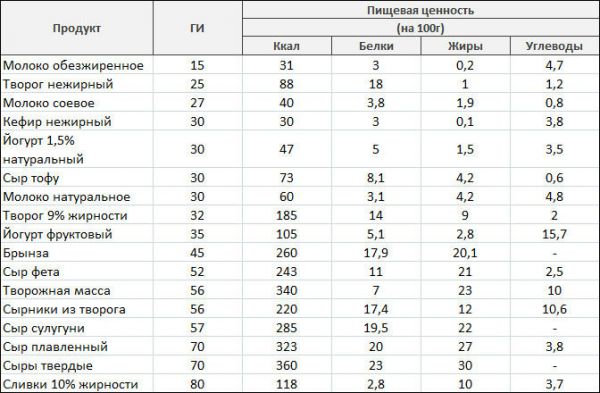
Dairy products are a storehouse of microelements for normal growth and development of the body
Advantages and disadvantages of low or high GI foods
According to scientists, any product with a high or low indicator has a number of advantages and disadvantages.
The positive aspects of a high GI include the following factors:
- blood sugar rises quickly;
- There is a feeling of a surge of strength and increased energy.
The disadvantages of these products are:
- the possibility of additional fat cells appearing in the body due to a sharp increase in blood sugar;
- insufficient time for the body to produce carbohydrates;
- strictly limiting the consumption of these products by diabetics.
Foods with a low glycemic index have a positive effect on the human body due to:
- uniform supply of glucose to the body throughout the day;
- completely eliminating the feeling of hunger, which helps reduce the likelihood of additional fat cells appearing.
The main disadvantages of these food products are considered to be the impossibility of their proper preparation , as well as their poor digestibility in the body during professional sports.
Average GI
| Product | GI |
| Wheat flour | 69 |
| fresh pineapple | 66 |
| instant oatmeal | 66 |
| Orange juice | 65 |
| jam | 65 |
| beets (boiled or stewed) | 65 |
| black yeast bread | 65 |
| marmalade | 65 |
| muesli with sugar | 65 |
| canned pineapple | 65 |
| raisin | 65 |
| maple syrup | 65 |
| Rye bread | 65 |
| boiled potatoes in their jackets | 65 |
| sorbent | 65 |
| yam (sweet potato) | 65 |
| whole wheat bread | 65 |
| canned vegetables | 65 |
| Pasta with cheese | 64 |
| sprouted wheat grains | 63 |
| wheat flour pancakes | 62 |
| pizza on thin wheat dough with tomatoes and cheese | 61 |
| banana | 60 |
| chestnut | 60 |
| ice cream (with added sugar) | 60 |
| long grain rice | 60 |
| lasagna | 60 |
| industrial mayonnaise | 60 |
| melon | 60 |
| oatmeal | 60 |
| cocoa powder (with added sugar) | 60 |
| fresh papaya | 59 |
| Arabic pita | 57 |
| canned sweet corn | 57 |
| grape juice (no sugar) | 55 |
| ketchup | 55 |
| mustard | 55 |
| spaghetti | 55 |
| sushi | 55 |
| bulgur | 55 |
| canned peaches | 55 |
| shortbread | 55 |
| basmati rice | 50 |
| cranberry juice (no sugar) | 50 |
| kiwi | 50 |
| pineapple juice without sugar | 50 |
| lychees | 50 |
| mango | 50 |
| persimmon | 50 |
| brown brown rice | 50 |
| apple juice (no sugar) | 50 |
READ MORE: Callanetics - what it is, how it affects weight loss, a set of exercises for beginners
Montignac diet based on the glycemic index: pros and cons
The Frenchman Michel Montillac, in his dietary methodology, divided foods into good and bad, compiling special tables with glycemic indices of foods.
From his recommendations it follows that eating carrots, white bread, honey, fried potatoes, buns, and drinking low-alcohol beer is not recommended for anyone at all because of their high glycemic index.
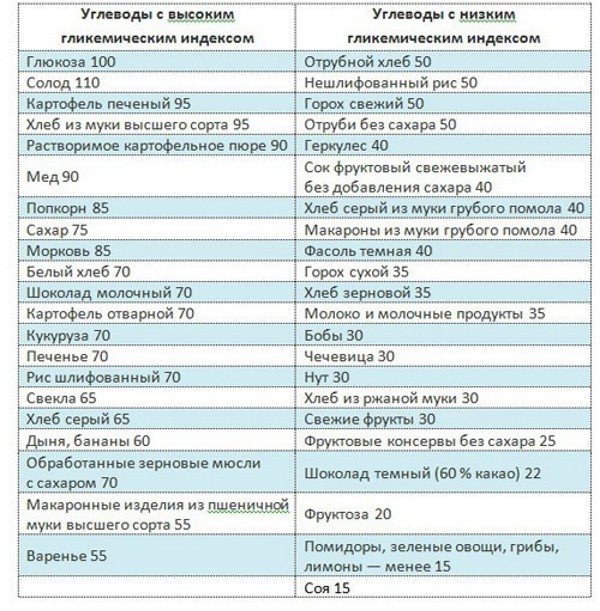
The essence of his teaching is that a person needs to change his diet and give up foods that contribute to weight gain.
But the French nutritionist does not impose a complete taboo on foods with a high glycemic index and says that they can be eaten, but not more than once or twice a week.
Vegetables
Vegetables are a source of vitamins, microelements, and fiber. The combination of this type of product in the diet has a beneficial effect on the human body, normalizes the functioning of the gastrointestinal tract, and increases the likelihood of absorption of each vitamin included in the composition. Vegetables should be an obligatory part of the daily menu of not only a sick person, but also a healthy person.
The products contain virtually no lipids and have low levels of proteins and carbohydrates. In most cases - low-calorie. The main value of vegetables is that they have a significant amount of ascorbic acid, pectin, folic acid, carotene, and minerals. The daily requirement is at least 600 g.
The table shows the GI indicators and calorie content of the most popular vegetables.

GI and calorie data - the ability to add or exclude necessary products
How to increase your vegetable consumption There are several tips to increase the number of “residents” of the garden bed in your daily diet:
Glycemic index of bread
- sandwiches with chopped vegetables;
- vegetable pizza;
- homemade sauces based on fresh or frozen vegetables;
- vegetable soups, borscht;
- if a person likes to eat in restaurants and cafes, order vegetable salads, snacks, baked vegetables as a side dish;
- Wash your favorite vegetables, cut them and put them in a visible place so that you will want to eat them;
- the nutritional value of frozen foods does not differ from fresh ones, so they can be safely added to first and second courses.
Stages of the Montillac diet
In Michel Montillac's method, the glycemic index of foods plays a significant role.
The nutritionist distinguishes 2 stages:
- Losing excess weight.
- Consolidation of achieved results for a long time.
First stage
The first stage involves complete abstinence from foods with large amounts of carbohydrates, where the GI is not higher than 40 units.
During this period, it is not recommended to mix foods containing carbohydrates and lipids. The second group of products includes eggs, vegetable oil and meat.
List of foods for breakfast, lunch and dinner
Breakfast No. 1: fruit. They are quickly digested in the stomach, promote excellent intestinal function, relieving a person from constipation.

The nutritionist advises eating low-fat yogurt or dairy products, cottage cheese, brown bread, oatmeal and unsweetened jams.
Breakfast No. 2: Taking into account the fact that soon after the first breakfast a person may feel an acute feeling of hunger, Montillac recommends a more substantial breakfast No. 2.
While taking it, you need food without carbohydrates: ham, cottage cheese, cheese, hard-boiled egg. You can also eat scrambled eggs.
Lunch: Lunch food should not be fatty. Foods can have lipids and proteins. It is recommended to prepare the first course from poultry, fish or meat , but on the obligatory condition that these products are grilled.
For those people who have decided to get rid of excess weight and lead a sedentary lifestyle, nutritionists will never recommend taking foods with a high glycemic index of 80 or more units (see the full table for weight loss)
For the second course - fresh vegetables in the form of a salad, but without the ingredients of carrots and beets. The glycemic index of foods for weight loss table clearly shows how high GI these 2 vegetables are endowed with.
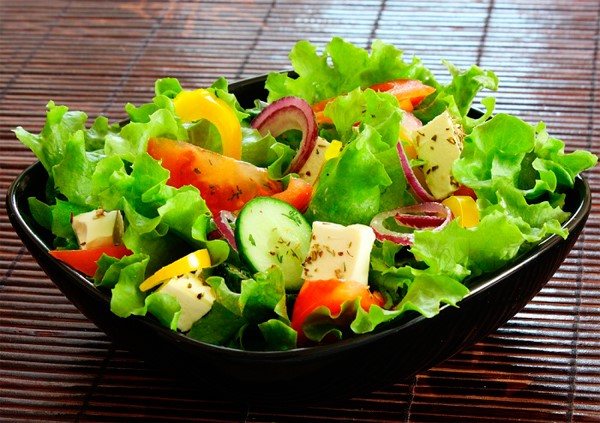
Dessert includes cottage cheese or yogurt, as well as cheese, but without bread.
Dinner: eating is recommended strictly at 19.00. Meals in the evening should be fairly light. You can cook vegetable soup from permitted products or eggs, poultry, fish . It won’t hurt to eat low-fat cottage cheese, eggplant, cauliflower, tomatoes, and green salad in the evening.
The second stage of weight stabilization
When the extra pounds are lost, the second stage of the Montillac diet begins, the goal of which is to maintain the gained weight for as long as possible.
During this period, it is allowed to expand the list of products. However, they should not contain high concentrations of sugar and fat.
Recommendations:
- after eating a piece of cheese or vegetable salad, you can drink champagne or light dry wine;
- You can add legumes to the list of products;
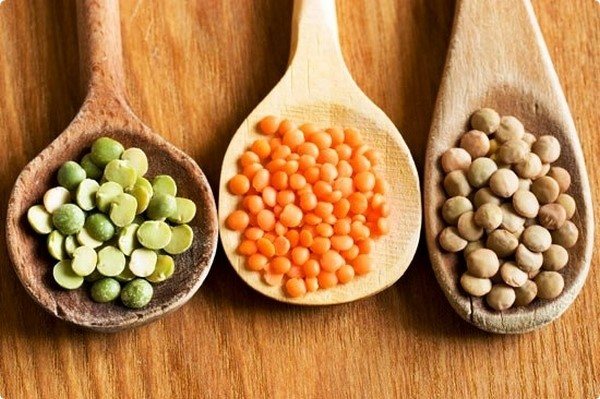
- vegetable margarine is an excellent substitute for butter; you need to increase the amount of fish meat;
- During breakfast, continue to eat wholemeal bread;
- is still unacceptable to consume desserts high in sugar and fat , honey, sweets, fizzy drinks such as lemonade, cola and various types of baked goods;
- Among non-carbonated drinks, caffeine-free coffee, weak tea without sugar or with a sweetener, as well as plain water with a volume of at least 2 liters are allowed. in a day.
Recipes using low GI foods
In this section, the emphasis will be on recipes using foods with a low glycemic index, taken from the weight loss table.
This food, after being digested in the stomach, saturates the human body with a small amount of glucose.
Meat cabbage soup
The recipe for dietary meat cabbage soup made from sauerkraut is as follows.
To prepare cabbage soup you will need:
- 570 g sauerkraut;
- 250 g lean beef;
- 50 g tomato paste;
- 500 g marrow bones;
- one onion, carrot, one parsley root;
- one glass of sour cream;
- 50 g each of ground parsley, dill, cilantro;
- or 3 cloves of garlic + other spices: bay leaf, pepper;
Cooking method:
- Root vegetables are chopped with a knife or grated. Next, they are placed in a frying pan and fried in oil and tomato sauce until fully cooked.
- Meat and bones are cooked for an hour and a half over medium heat. Then they are taken out of the broth, and it itself is filtered.
- The cabbage from the tub is washed in cold water, large pieces are chopped with a knife, then it is stewed for 1 hour in vegetable oil.
- Once ready, root vegetables and fried cabbage are placed in meat broth, to which salt to taste, bay leaf and peppercorns are also added. The pan is placed on the fire. The cabbage soup is ready as soon as the boiling process begins.
- The soup is served with sour cream, seasoned with finely chopped garlic and herbs.
Braised cabbage
The recipe for dietary stewed cabbage cooked in a Dutch oven is as follows.

Required:
- half a small head of cabbage;
- carrots, onion, bell pepper – 1 piece;
- 100 ml water and tomato paste;
- vegetable oil - 20 ml;
- bay leaf, red and black pepper. Everything is added to taste.
Cooking method:
- Cabbage is cut into thin long slices.
- Place in a roasting pan, add water and simmer for a quarter of an hour over low heat.
- During stewing, the contents of the frying pan must be stirred regularly so that it does not burn.
- After 15 minutes, tomato paste is added, which must be mixed well with the cabbage; The extinguishing process continues for another quarter of an hour.
- Then spices are added with vegetable oil . Mix everything again and simmer for about 5 more minutes. But if the water has not evaporated from the frying pan, the process of simmering on the fire must be extended until it is completely evaporated.
healthy food is one that does not allow the accumulation of cholesterol in the blood and an increase in the number of fat cells in the body.
Nutritionists say that regular consumption of this dish helps you lose several kilograms of weight at once.
Salad with chicken, cucumbers and avocado
The recipe for salad with chicken, avocado and fresh cucumber is as follows.

You will need:
- 300 g chicken meat;
- 1 piece - avocado, onion, egg;
- 2 cucumbers;
- 4 potatoes;
- 200 g mayonnaise.
Method of preparation: first boil the chicken meat, then cool it and cut it into small pieces. Potatoes boiled in their jackets are peeled and also cut into small cubes.
The pit is removed from the peeled avocado and it is also cut into small pieces. The peel is cut off from the cucumbers, and then they are finely chopped.
The boiled egg is grated. All ingredients are placed in a salad bowl, seasoned with mayonnaise and mixed.
How to use GI for diabetes and weight loss
The common belief that if you have diabetes you need to follow a strict diet is very erroneous.
According to diabetic patients, they can eat everything, but do not forget to measure their blood sugar levels and take insulin injections on time.
A table of foods for weight loss with the glycemic index of foods for diabetes was also developed by nutritionist Montillac.
People with this congenital or acquired disease should carefully read the entire list of products recommended for losing excess weight and choose the optimally acceptable food.
The above list is not a panacea. But people with diabetes, who were overweight and obese, chose foods that were acceptable to them from the table presented and, by eating them, lost excess weight.
Fruits and berries
A fruit is a juicy fruit of a bush or tree suitable for consumption. These products are valuable for their rich composition (especially vitamin C), which is indispensable for daily consumption. In terms of energy ratio, most fruits have the following composition:
- proteins – about 10%;
- lipids – about 3-5%;
- carbohydrates – 85-90%.
High levels of carbohydrates do not prevent even people with diabetes from including foods in their diet, since there are a number of fruits that have low glycemic index values. Fiber and a rich vitamin and mineral composition will only be beneficial.
Berries are a storehouse of essential substances. Their beneficial properties are aimed at restoring the body’s immune defense, cleansing, and saturating cells and tissues with vitamins and microelements.
Fruits and berries have the following composition:
- beta-carotene;
- B-series vitamins;
- tocopherol;
- a nicotinic acid;
- trace elements (potassium, iron, manganese, calcium);
- essential amino acids;
- bioflavonoids.
The above substances are necessary to strengthen vascular walls and increase their elasticity, stabilize blood pressure, and normalize metabolism. They are able to protect the body from free radicals, improve blood supply, have an antitumor effect, and restore defenses.

Fruits and berries are irreplaceable products in the daily menu of a healthy person and a diabetic
